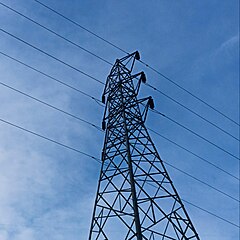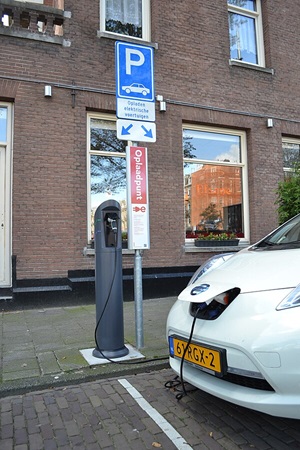Pressure on the electricity grid gets heavier all the time. Many corporations and organisations aim to get more sustainable. But there are bottlenecks. Because at times, there is a glut of sustainable electricity (mainly solar and wind power), and at times, too little of it. How do we solve these? Can we use electricity more cleverly?

Clever use of electricity
An article by Jeannette Verleg on change.inc (all links in Dutch) treats this question. Solar and wind energy are weather dependent, and demand for electricity has a dynamic of its own. Therefore, corporations will have to treat energy in another, more strategic way. Although this will be different for each company. For some, the solution may be the installation of solar panels, charging stations and a smart battery. Like at Oegema Transport. The battery tunes in on the market’s price level. It produces electricity for the fast-chargers if the grid’s capacity falls short. And if there is an excess of electricity, it can trade that on the market.
Control technology
Dutch retailer Albert Heijn uses a comparable system in its electricity grid. Their charging stations, solar panels and batteries are smartly directed by a Virtual Power Plant, operated by electricity company Eneco. This virtual electricity power plant levels out as much as possible, differences in supply and demand. On the one hand, the VPP smartly determines production, and on the other hand the lack or excess of electricity is traded on a number of energy markets. The system has the effect of using as much sustainable electricity as possible.
We can also apply smart control on a smaller scale. Eneco makes available to companies with over one hundred solar panels a control box, free of charge. Connected to a Virtual Power Plant. This can control electricity production, by dimming it or even turning it off at peak moments. This will optimize for the customer the financial benefits of the solar panels; while it allows Eneco to take care of better electricity grid stability on the local or national level.

Long waiting lists
But still, this practice falls short of what we need. In the Netherlands, there are long waiting lists for the connection of solar panels to the electricity grid; and there is a growing pile of requests for new wind parks. National grid company Tennet is being confronted with more than 40 gigawatt of new projects. For the time being, consumers will not carry the burden, for connecting existing homes has priority. The same holds for new housing projects. But companies and organisations that apply for a new connection, will be added to the waiting list. The same holds true for individual consumers who need a heavier connection.
What can we do about this? We can build new capacity. A no-brainer, so it would seem; but this solution will demand time and capacity. A reasonable expectation is that the electricity grid will have been strengthened enough in some eight to ten years, in order to meet present demand. But by that time, that may not be sufficient anymore.
Energy storage
Another solution is to make use of spare capacity. The electricity grid has been constructed at a double capacity. The so-called hard shoulder will only be used if something gets broken. That happens a few times each year. We can use the hard shoulder for enlarging capacity; the consequence is that electricity supply will be interrupted in case of a problem emerging.
Another solution would be to buy back the unused (but contracted) capacity at major clients. That will create space for new clients. Or we could store energy, for instance in batteries or in hydrogen. The problem being that in that case, a lot of energy will be lost. Or consumers could change their behaviour; if stimulated to do so by the tariff. Washing the laundry as the sun shines; use less if skies are clouded or if there is no wind. Or we could exchange electricity with other countries. Norway for instance has a lot of hydropower, whereas the Netherlands will produce ever more electricity from wind.
Smart solutions
Smart solutions pop up. Dutch employers’ organization VNO/NCW listed a few of them. In the town of Hendrik-Ido Ambacht, entrepreneurs started an ‘energy hub’, a cooperative energy company. It has a software system that allows them to trade energy and smooth down demand peaks. The companies will be able to enlarge this system with heat pumps and cooling devices, and an energy storage system. That will prevent congestion of the network.
On an industrial area in the Dutch town of Eindhoven, entrepreneurs did something comparable. All companies together claimed far too much energy. But it appeared that they claim that at different moments. They now mounted an energy unit of their own. It houses heat pumps, cooling devices, compressors for compressed air, et cetera. Together they mounted solar panels, and a battery, as well as a device for storing heat and cold, and an e-boiler. Companies exchange residual streams. The joint venture guarantees a 99.5% delivery of all required services.
Combine green electricity and storage
Albert Heijn mounted solar panels on the roofs of their shops. They use the electricity for powering their electric trucks. The combination with a large battery makes sure that most of the time, trucks have enough power to supply the shops, and return.
In short, we will have to combine the opportunities for generating sustainable electricity with storage. That will boost the capacity of the electricity grid. Moreover, we can also use energy more wisely. Maybe, the combination of the two will not always deliver a solution – but it will do so quite often, anyway.
Interesting? Then also read:
Local grid optimization
Energy storage will accelerate the transition
Local network required against grid congestion
